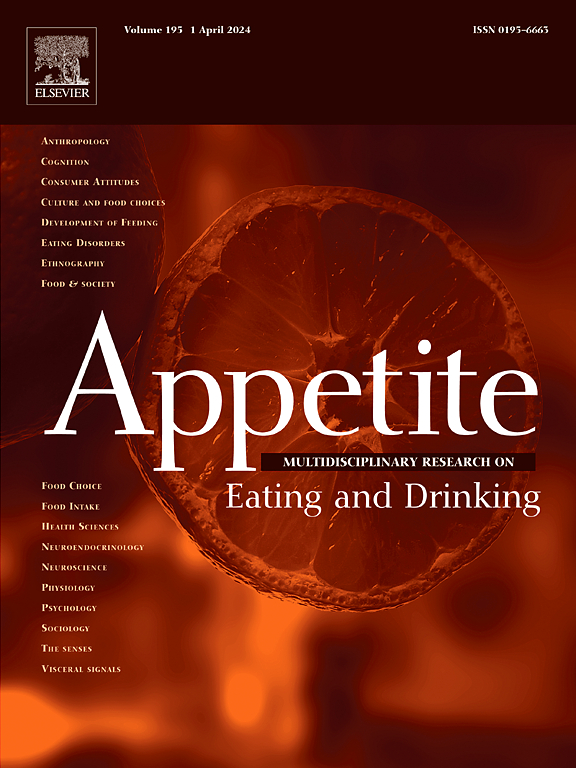自我控制和饮食限制与怀孕和产后家庭食物环境的关系
IF 3.8
2区 医学
Q1 BEHAVIORAL SCIENCES
引用次数: 0
摘要
考虑到家庭食物环境对儿童饮食质量、食物偏好和相关健康结果的影响,了解父母对家庭食物环境的影响至关重要。本研究探讨家庭饮食环境与育龄父母自我控制及饮食节制的关系。数据来自妊娠饮食特征研究(PEAS),该研究从怀孕的头三个月一直追踪到产后一年。参与者在怀孕早期和产后六个月自我报告了自我控制(冲动,延迟满足),饮食限制和家庭食物环境(家中水果和蔬菜的数量以及致肥食物)。线性回归估计了每个时间点的自我控制和饮食限制与家庭食物环境的关系,控制了社会人口统计学。乘法相互作用项测试了饮食限制是否改变了自我控制与家庭食物环境的联系。在怀孕期间,更延迟的满足感和饮食限制与更低的致肥食物供应和更多的水果和蔬菜供应有关。较低的冲动也与更多的水果和蔬菜有关。较低的饮食限制放大了满足延迟和冲动与水果和蔬菜供应的联系。在产后,较低的冲动与更多的水果和蔬菜供应有关;然而,没有其他的联系冲动,延迟满足,或饮食限制与家庭食物环境。与产后相比,怀孕期间更强的自我控制和饮食限制与更健康的家庭食品环境之间的联系更为一致,这表明针对怀孕期间家庭食品环境的干预措施可能对自我控制或饮食限制较低的个体有更大的益处。本文章由计算机程序翻译,如有差异,请以英文原文为准。
Associations of self-control and dietary restraint with the home food environment during pregnancy and postpartum
Understanding parental influences on the home food environment is critical given the effects of the home food environment on child diet quality, food preferences, and related health outcomes. This study examines relationships of the home food environment with self-control and dietary restraint in childbearing parents. Data are from the Pregnancy Eating Attributes Study (PEAS), which followed participants from the first pregnancy trimester through one-year postpartum. Participants self-reported self-control (impulsivity, delay of gratification), dietary restraint, and the home food environment (number of fruit and vegetables and obesogenic foods in the home) in early pregnancy and six months postpartum. Linear regressions estimated relationships of self-control and dietary restraint with the home food environment at each timepoint, controlling for sociodemographics. Multiplicative interaction terms tested whether dietary restraint modified associations of self-control with the home food environment. During pregnancy, greater delay of gratification and dietary restraint were associated with lower obesogenic food availability and greater fruit and vegetable availability. Lower impulsivity was also associated with greater fruit and vegetable availability. Lower dietary restraint magnified associations of delay of gratification and impulsivity with fruit and vegetable availability. In postpartum, lower impulsivity was associated with greater fruit and vegetable availability; however, there were no other associations of impulsivity, delay of gratification, or dietary restraint with the home food environment. More consistent associations of greater self-control and dietary restraint with a healthier home food environment in pregnancy than postpartum suggest that interventions targeting the home food environment during pregnancy may offer greater benefit to individuals with lower self-control or dietary restraint.
求助全文
通过发布文献求助,成功后即可免费获取论文全文。
去求助
来源期刊

Appetite
医学-行为科学
CiteScore
9.10
自引率
11.10%
发文量
566
审稿时长
13.4 weeks
期刊介绍:
Appetite is an international research journal specializing in cultural, social, psychological, sensory and physiological influences on the selection and intake of foods and drinks. It covers normal and disordered eating and drinking and welcomes studies of both human and non-human animal behaviour toward food. Appetite publishes research reports, reviews and commentaries. Thematic special issues appear regularly. From time to time the journal carries abstracts from professional meetings. Submissions to Appetite are expected to be based primarily on observations directly related to the selection and intake of foods and drinks; papers that are primarily focused on topics such as nutrition or obesity will not be considered unless they specifically make a novel scientific contribution to the understanding of appetite in line with the journal's aims and scope.
 求助内容:
求助内容: 应助结果提醒方式:
应助结果提醒方式:


